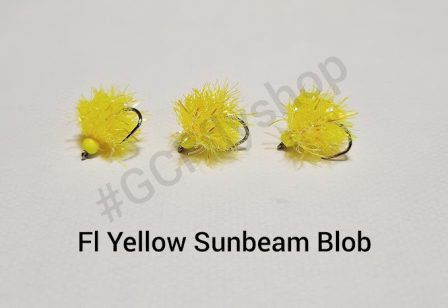Hint’s & tip’s on how to fish the blob fly.
What is a blob fly?
The blob fly is a short and bulky trout fly made from colourful (often orange) fritz wrapped around a short shank wide gape hook.
It’s often said that the blob imitates a cloud of Daphnia, but it isn’t actually supposed to be a natural imitation of anything. Instead, it’s an attractor pattern designed to grab the attention of passing trout.
Who invented the blob?
The blob was invented by Coventry-based fly fisherman Paul McLinden who, despite being Scottish, is an England International fly angler.
He tied the original blob using orange fritz on a size 10 competition rules double hook (a trick to help the fly sink without the need to add wire or a bead, which would contravene the rules). McLinden’s blob had an orange posted wing, but that fell off while he was fishing it. The wingless blob out-fished his boat partner’s fly and the modern blob was born.
The current generation of blobs have moved a little away from McLinden’s original incarnation. Some fly tyers have added tinsel, a bead or a hot head of Glo Brite floss. But all blobs consist of a dense fritz body, usually with little or no tail and usually no wing, and they’re now tied on a single hook.
How do you fish a blob fly?
Although you can fish the blob on its own, this trout fly comes into its own when used as an attractor pattern. It is usually combined with a team of two (or even three) duller, more natural patterns, such as , buzzers, nymphs or Diawl Bachs.
“The blob works brilliantly as an attractor on the top dropper, but is just as good when used on the point as a pulling lure”
It’s more common for the blob to be fished on the top dropper, where it attracts the attention of trout who often follow it attentively and then turn away and take one of the natural patterns on the middle dropper or the point.
However, you can also fish it on the point. Here, it’s slow descent helps keep the buzzers falling through the water slowly and steadily, and is often taken itself, as well as attracting the attention of trout to the buzzers.
How do you retrieve a blob?
There’s more than one way to retrieve a blob, making it a very versatile trout fly. It can be fished static, you can retrieve it with a slow figure of eight, you can pull it back in short sharp jerks or you can roly poly retrieve it at speed.
A figure eight retrieve has always been most effective for me, but for many people it’s a fly associated with pulling.
Some anglers at my local fishery swear by fishing it completely static under an indicator. Suspend it a few feet under an indicator and wait for the indicator to shoot away as it’s taken by a trout.
What line should I use when fishing the blob?
A floating line is the most common way to fish a blob, however, an intermediate or sinking line can work well in certain conditions.
If you’re fishing a sinking line or using the washing line technique there are also booby blobs and a foam arsed blob (or FAB) to keep the blob higher in the water column.
Where the fishery rules allow, fishing floating blobs or fabs on a sinking line can be a great way to catch fish holding near the bottom on very deep lakes. Here, you use a relatively short leader, of a few feet or so, cast our your sinking line and wait for it to hit the bottom.
Every so often you give a little tug on the line, but generally don’t retrieve at all. The low lying trout are attracted to the movement of the FABs and the sinking line will shoot off.
